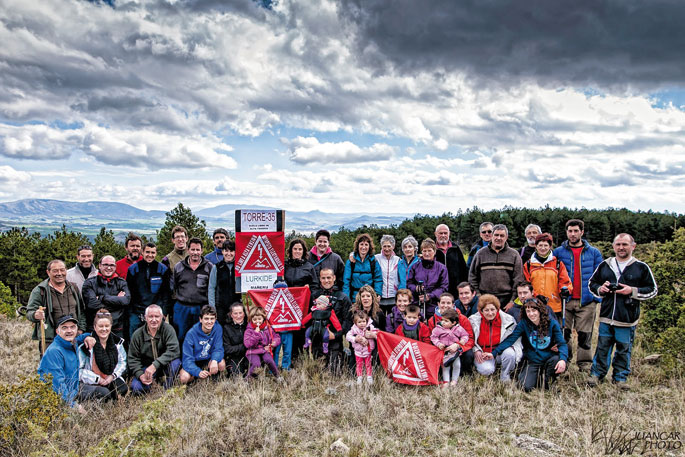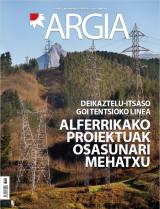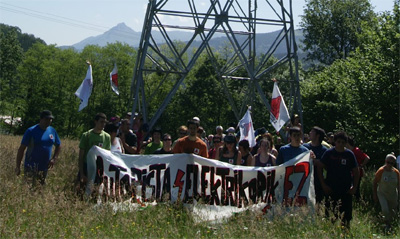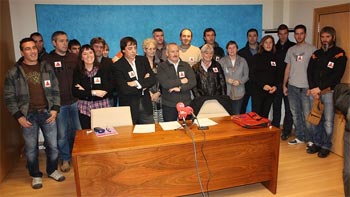System High Tension Veins
- The Council of Ministers of the Spanish Government approved the 2015-2020 Energy Plan in October. Between Dicastillo (Navarra) and Ezdox-Itsaso (Gipuzkoa) is the 400 kV line that Electricity Network of Spain intends to build. One more step in the implementation of the project.

We often don't realize that our sky is plagued by cables that cross from one part to another. In the landscape of the Basque Country, electric transport lines have become common, and we already have several high-voltage lines.
In 2011, Red Eléctrica de España (REE) introduced the 400,000 volt line project, which would link Dicastillo with Eztango-Itsaso. However, it was not a project from scratch, but a continuation of the abandoned high-voltage line Dicastelu-Vitoria. As they published in the Official Gazette of the Spanish State, this first project was rejected "for the damage caused to the environment and by the existing opposition" and replaced by that of Dicastillo.
“Approaching the distant and moving away the near”
Attorney and Platform Member No to the Electric Highway, Alberto Frias, explained what the idea of the electric highway is: “It has similarities with the land highways, but it goes through the air: just as in the highways there are tolls in the entrances and exits of the villages, the high-voltage line needs substations to take or raise the energy.”
Although the project originally included the Dicastillo substation, the recently approved 2015-2020 Energy Plan has been removed. This means that the line cannot be used for local needs.
The high-voltage line would have a route of 129 kilometres, and many towns and councils of Navarre and Gipuzkoa would be affected on that route. The towers in the Basque Country will be invisible if the project goes ahead: It is an 85 meter tall tower, the same as the BBVA tower in Bilbao. In addition, being an electricity transit line, the number of cables – and their influence – is doubling: 18 drivers in total.
The new 400 kV line is not enough, as the two 220 kV lines between Orkoien and Itsaso, which are already on the same route, have been reinforced in the Energy Plan. Frias has stressed that the electromagnetic impact in this section, which would be located in the Irurtzun area and run parallel to Gipuzkoa, will be "brutal".
The impact of the high-voltage line would affect many areas. Damage to the landscape and the environment is evident: The line runs between protected areas of the Natura 2000 network, as ecological corridors between the areas of Urbasa Andía, Aralar, Aizkorri and Oriagoiena. It would directly affect animals and, above all, protected birds, such as the quebrantabones and the black eagle, as Frias ironically says “because birds do not adapt very well with eighteen cables of this level of tension”. It would also affect the vegetation, as they would be sliced, beech and oak.
Apart from the environment, the construction of the line would have a direct impact on the lives of these peoples and their inhabitants. On the one hand there is health. In a video of the platform you can see how a fluorescent lamp turns on on on its own under a line of this kind. What effects can this level of electromagnetic field have on health? Many citizens are concerned about that, and some are thinking of leaving their people of origin.
The precautionary principle of the European Union says that 100 volts need a safety distance of one meter. In this case, a half-kilometre stretch on either side of the line would be required, one kilometre in total. Within this section there would be sixteen peoples. The minimum levels laid down have therefore not been respected. And beyond the urban centers, they have not taken into account many other places: rural neighborhoods, campsites, industrial sites where people live, soccer fields...
In addition, the mayor of Mutiloa, Iñaki Ugalde, explained that the project clashes frontally with the people’s approach to spatial planning. In Mutilva, as in other localities of the Goierri, cultural heritage is being valued and the old mines in the area are being recovered, thinking about the future of the people and tourism. The same happens in Puente la Reina with the Camino de Santiago, or in Dicastillo with the wineries producing organic wine. The line is incompatible with all these activities.
And all that for what?
The members of the No Electric Highway platform denounced from the outset that the objective of this high-voltage line is not to meet local energy needs. They say that in order to deal with possible energy imbalances, it would be enough to reinforce the lines already built.
“In the peninsular energy system there is too much power installed: 100,000 megawatts, and the maximum demand has never risen from 44,000 megawatts. That’s before the crisis,” explains Frias. What does this mean? That there is a capacity to generate more energy than is needed – the installed power doubles the peak of demand – and that, as electricity cannot be stored, you have to go outside. A clear example is the Castejón thermal power plants, which after leaving a lot of money in their construction and maintenance are paralyzed because “the system does not need it”.
According to REE data, in recent years energy exports have been higher than imports. And in the 2015-2020 Energy Plan it is clear that the new high-voltage line will be used for the transport of energy to the French state.
Citizenship and local authorities vs. governments
The energy supply in Tierra Estella was the reason why the previous government of Navarra strongly supported the project for many years. The disappearance of the Dicastillo substation, at the same time as the project, has been suspended. “The 2015-2020 Energy Plan has taken up what has so far been denied us by the CAPV Government and, above all, that of Navarra: that the high-voltage line, more for local needs, is to bring electricity to France,” says Frias.
On several occasions, the platform has asked the new Government of Navarra to withdraw the project, but Frias has denounced that they have not yet received any reply: “It is a shame that the change government takes a ‘Don’t Know/Don’t Answer’ position on this issue.”
While the competence of the high-voltage line lies with the State, electricity planning requires projects to be consulted and communicated with local governments. The Basque Government and the Government of Navarre have refused to accept this consultation or have been consulted on behalf of the municipalities concerned. “They have not complied with their obligations: they have not provided technical assistance to the municipalities, nor have they communicated the deadlines. The platform has had to be filling the gaps in public information.”
However, in the face of the silence of the governments of the CAV and Navarre and the inertia, a broad opposition movement was created in the villages through which the line passes. Municipalities, citizens and associations have met on the No Electric Highway platform and in recent years work has been done to paralyse the project.
In December 2011, a total of 470 municipal officials requested the foral and autonomic government to shut down the project in Berriozar. The motions requesting it had previously been approved by 220 municipalities and councils.
In these peoples there are representatives of many political parties, but, interestingly, they have all come to a total agreement on this issue: no one is in favour of the line. Since the beginning of the new legislature in the municipalities, the new corporations have been tabling motions to ratify the position of the previous municipal governments.
But the project continues and Frias explains that they have already taken an important step with the adoption of the 2015-2020 Energy Plan: “All they have left is to approve the environmental impact statement and make it public. That is, a simple administrative procedure.”
“No, no, no, no, no high voltage”
Since the launch of the 400 kV line project, activities and activities of all kinds have been organized in the villages. Some convened by the platform, unified and others at local level: demonstrations, mountain marches, talks, parliamentary hearings, blackouts, press conferences... There has been no lack of tension against the high-voltage line.
For example, the 2012 Alsasua Declaration: 417 people from the world of health, culture, education and sport signed the document “to guarantee the future of peoples and to claim the right to live in them with dignity”.
In June 2013 popular consultations were held in 40 localities affected by the high-voltage line. Once again, the citizens' response was clear: 63% of the registered population participated in the consultations and 99% voted against the project.
It is also significant that the project that has received the most allegations in the Basque Country has been the high-tension line Dicastelu-Itsaso. In Navarre and Gipuzkoa, 14,000 claims were made by citizens, municipalities, councils and associations from different areas, each with their contribution from their respective areas. To this day, everyone remains unanswered.
Diversity has been from the very beginning one of the hallmarks of the movement against the electric highway. The “Lurkide Eguna”, organised in 2014, very well reflected the nature of the struggle. On that day, the 129 kilometres that would occupy the high-tension line were filled with the gigantic human chain, located in the 247 areas where the towers of the various groups and associations of the peoples would be found. These included parent associations, youth assemblies, choirs, football teams, hunters, cultural groups, mountain groups and many other actors.
That is what the Mayor of Mutilva, Iñaki Ugalde, wanted to stress: on the one hand, the union between citizens and, on the other, the relations between peoples. “The dynamic between the villages of the valley has been beautiful, we have known each other. Also many towns of Navarre. That’s what this struggle has given us.”
Big power companies win
Frias is clear that the high voltage line fits a model: “We live in a country based on the intensive consumption of energy and capital. Torre Iberdrola and Torre BBVA: The sky of Euskal Herria is dominated by the model of those two flaws that ‘penetrate’”.
And who will be the winners of the high-voltage line? Electricity Network of Spain – privatized entity – and large power companies, especially Iberdrola, that control the field. In February of this year, the Electric Highway Ez platform denounced in Pamplona the “revolving doors” surrounding these companies.
As for the alternatives, the idea of energy efficiency has come to light. Today, one third of the original energy is lost in transport. We have a totally ineffective system and with these high-voltage lines the centralisation of production points is encouraged, precisely when the way to reduce losses is the opposite: to bring the point of production of energy to the point of consumption as much as possible. Moreover, it is clear that energy saving is also essential.
Finally, Frias referred to alternative energies: “Alternative energies are not the same as renewables. Being renewable is not good in itself: The wind energy of Navarra has not been replaced, for example, by the Castejón thermal, which has used it as an additive”. Renewables yes, but alternatives.
Martxoaren 19an amaitu zen proiektua aurkezteko epea, baina Errioxako PSOEk adierazi du Forestalia enpresak "interesa baztertu" duela. Enpresak bi parke eoliko eraiki nahi zituen Aragoiko lurretan, baina oraindik ez ditu lortu baimenak eta hori dute egitasmoa... [+]
Forestalia enpresak Nafarroan beste poligono eoliko bat eraikiko duela jakinarazi du Sustrai Erakuntza Fundazioak. Nafarroari eragiten dioten goi-tentsioko bi linea ere baditu enpresa honek.
Autopista elektrikorik ez! plataformak larunbatean Iruñean emandako prentsaurrekoan jakinarazi du atzera bota dutela Itsaso eta Deikaztelu batzen dituen tentsio handiko linearen eraikuntza.
Gueñesetik Itsasora (Gipuzkoa) goi tentsioko linea elektriko bat sortzeko proiektua zabaldu zen 2011n. Alegazioen ostean, sei urtez stand-by egoeran egon da, eta orain, Espainiako gobernuak berriro aktibatu gura du, 2018an eraikitzen hasteko. Bada, egitasmoaren aurkako... [+]
Itsaso eta Deikaztelu arteko Autopista Elektrikoaren aurkako Plataformak Goi-tentsio linearik ez – ate birakariei ez lelopean Nafarroako Gobernuaren aurrean kontzentrazioa deitu du larunbat eguerdirako.
Ezkio-Itsaso eta Deikaztelu lotuko dituen goi tentsioko linearen inguruko galdeketa egin dute asteburuan Gipuzkoa eta Nafarroako 39 herritan. Orotara 5.156 lagun zeuden bozkatzera deituta, eta %63ak hartu du parte. Horietatik %99,32 proiektuaren aurka azaldu da.
REE (Red Eléctrica de España) enpresak Itsaso (Gipuzkoa) eta Deikaztelu (Nafarroa) artean eraiki nahi duen goi tentsioko linea ez egiteko eskatu dute hainbat kirolarik. Tartean dira, besteak beste, Itxako eskubaloi taldeko Andrea Barno, Nerea Pena eta Naiara... [+]
REE (Red Eléctrica de España) enpresak Itsaso (Gipuzkoa) eta Deikaztelu (Nafarroa) artean eraiki nahi duen goi tentsioko linearen aurkako mozioa onartu dute Gipuzkoa eta Nafarroako ehun udalek. Linea berriak 120 kilometro luze izango lituzke, eta 400.000 voltioko... [+]























